常见的修辞格翻译5
- 格式:ppt
- 大小:310.00 KB
- 文档页数:54
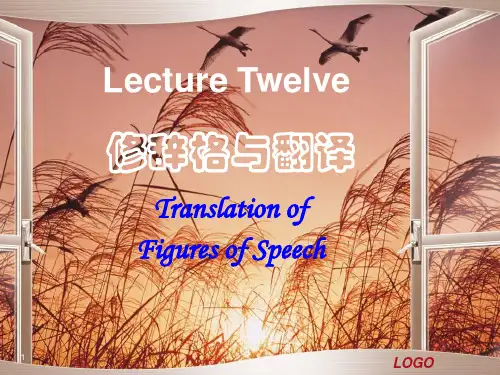
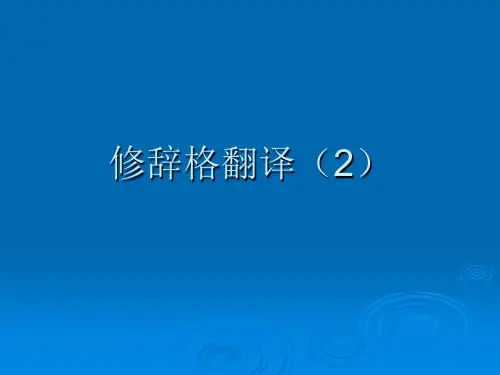
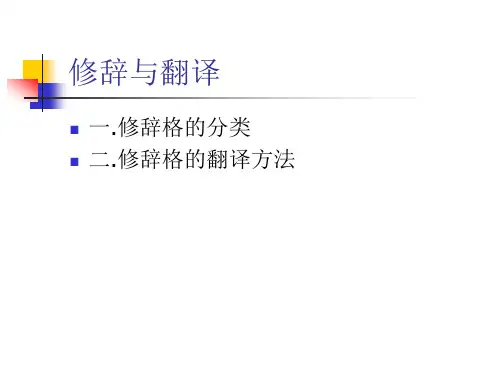
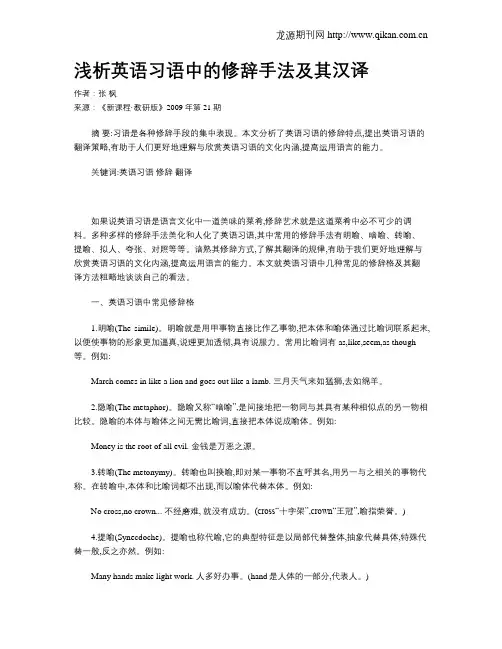
浅析英语习语中的修辞手法及其汉译作者:张枫来源:《新课程·教研版》2009年第21期摘要:习语是各种修辞手段的集中表现。
本文分析了英语习语的修辞特点,提出英语习语的翻译策略,有助于人们更好地理解与欣赏英语习语的文化内涵,提高运用语言的能力。
关键词:英语习语修辞翻译如果说英语习语是语言文化中一道美味的菜肴,修辞艺术就是这道菜肴中必不可少的调料。
多种多样的修辞手法美化和人化了英语习语,其中常用的修辞手法有明喻、暗喻、转喻、提喻、拟人、夸张、对照等等。
谙熟其修辞方式,了解其翻译的规律,有助于我们更好地理解与欣赏英语习语的文化内涵,提高运用语言的能力。
本文就英语习语中几种常见的修辞格及其翻译方法粗略地谈谈自己的看法。
一、英语习语中常见修辞格1.明喻(The simile)。
明喻就是用甲事物直接比作乙事物,把本体和喻体通过比喻词联系起来,以便使事物的形象更加逼真,说理更加透彻,具有说服力。
常用比喻词有as,like,seem,as though 等。
例如:March comes in like a lion and goes out like a lamb. 三月天气来如猛狮,去如绵羊。
2.隐喻(The metaphor)。
隐喻又称“暗喻”,是间接地把一物同与其具有某种相似点的另一物相比较。
隐喻的本体与喻体之间无需比喻词,直接把本体说成喻体。
例如:Money is the root of all evil. 金钱是万恶之源。
3.转喻(The metonymy)。
转喻也叫换喻,即对某一事物不直呼其名,用另一与之相关的事物代称。
在转喻中,本体和比喻词都不出现,而以喻体代替本体。
例如:No cross,no crown... 不经磨难, 就没有成功。
(cross“十字架”,crown“王冠”,喻指荣誉。
)4.提喻(Synecdoche)。
提喻也称代喻,它的典型特征是以局部代替整体,抽象代替具体,特殊代替一般,反之亦然。
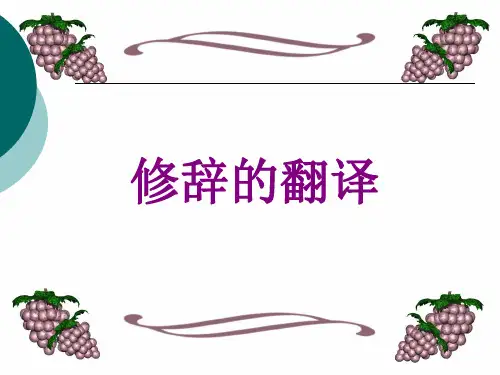
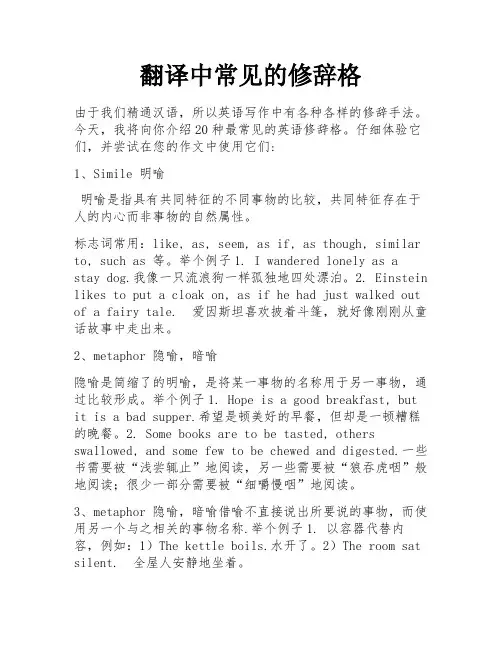
翻译中常见的修辞格由于我们精通汉语,所以英语写作中有各种各样的修辞手法。
今天,我将向你介绍20种最常见的英语修辞格。
仔细体验它们,并尝试在您的作文中使用它们:1、Simile 明喻明喻是指具有共同特征的不同事物的比较,共同特征存在于人的内心而非事物的自然属性。
标志词常用:like, as, seem, as if, as though, similar to, such as 等。
举个例子1. I wandered lonely as astay dog.我像一只流浪狗一样孤独地四处漂泊。
2. Einstein likes to put a cloak on, as if he had just walked out of a fairy tale. 爱因斯坦喜欢披着斗篷,就好像刚刚从童话故事中走出来。
2、metaphor 隐喻,暗喻隐喻是简缩了的明喻,是将某一事物的名称用于另一事物,通过比较形成。
举个例子1. Hope is a good breakfast, but it is a bad supper.希望是顿美好的早餐,但却是一顿糟糕的晚餐。
2. Some books are to be tasted, others swallowed, and some few to be chewed and digested.一些书需要被“浅尝辄止”地阅读,另一些需要被“狼吞虎咽”般地阅读;很少一部分需要被“细嚼慢咽”地阅读。
3、metaphor 隐喻,暗喻借喻不直接说出所要说的事物,而使用另一个与之相关的事物名称.举个例子1. 以容器代替内容,例如:1)The kettle boils.水开了。
2)The room sat silent. 全屋人安静地坐着。
2. 以资料、工具代替事物的名称,例如:Lend me your ears, please. 请听我说。
3. 以代替作品,例如:a plete Shakespeare 莎士比亚全集4. 以具体事物代替抽象概念,例如:I had the muscle, and they made money out of it. 我有力气,他们就用我的力气赚钱。
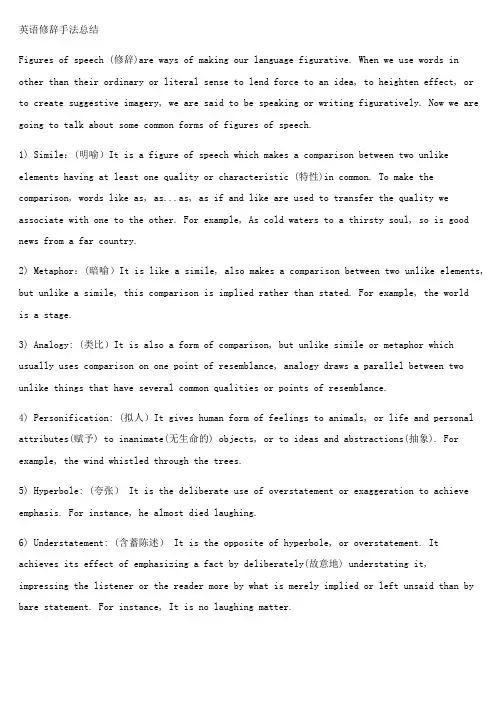
英语修辞手法总结Figures of speech (修辞)are ways of making our language figurative. When we use words in other than their ordinary or literal sense to lend force to an idea, to heighten effect, orto create suggestive imagery, we are said to be speaking or writing figuratively. Now we are going to talk about some common forms of figures of speech.1) Simile:(明喻)It is a figure of speech which makes a comparison between two unlike elements having at least one quality or characteristic (特性)in common. To make the comparison, words like as, as...as, as if and like are used to transfer the quality we associate with one to the other. For example, As cold waters to a thirsty soul, so is good news from a far country.2) Metaphor:(暗喻)It is like a simile, also makes a comparison between two unlike elements, but unlike a simile, this comparison is implied rather than stated. For example, the worldis a stage.3) Analogy: (类比)It is also a form of comparison, but unlike simile or metaphor which usually uses comparison on one point of resemblance, analogy draws a parallel between two unlike things that have several common qualities or points of resemblance.4) Personification: (拟人)It gives human form of feelings to animals, or life and personal attributes(赋予) to inanimate(无生命的) objects, or to ideas and abstractions(抽象). For example, the wind whistled through the trees.5) Hyperbole: (夸张) It is the deliberate use of overstatement or exaggeration to achieve emphasis. For instance, he almost died laughing.6) Understatement: (含蓄陈述) It is the opposite of hyperbole, or overstatement. Itachieves its effect of emphasizing a fact by deliberately(故意地) understating it,impressing the listener or the reader more by what is merely implied or left unsaid than by bare statement. For instance, It is no laughing matter.7) Euphemism: (委婉) It is the substitution of an agreeable or inoffensive(无冒犯) expression for one that may offend or suggest something unpleasant. For instance, we refer to "die" as " pass away".8) Metonymy (转喻)It is a figure of speech that has to do with the substitution of the mane of one thing for that of another. For instance, the pen (words) is mightier than the sword (forces).9) Synecdoche (提喻) It is involves the substitution of the part for the whole, or thewhole for the part. For instance, they say there's bread and work for all. She was dressedin silks.10) Antonomasia (换喻)It has also to do with substitution. It is not often mentioned now, though it is still in frequent use. For example, Solomon for a wise man. Daniel for a wise and fair judge. Judas for a traitor.11) Pun: (双关语) It is a play on words, or rather a play on the form and meaning of words. For instance, a cannon-ball took off his legs, so he laid down his arms. (Here "arms" has two meanings: a person's body; weapons carried by a soldier.)12) Syllepsis: (一语双叙) It has two connotations.In the first case, it is a figure by which a word, or a particular form or inflection of a word, refers to two or more words in the same sentence, while properly applying to or agreeing with only on of them in grammar or syntax(句法). For example, He addressed you and me, and desired us to follow him. (Here us is used to refer to you and me.)In the second case, it a word may refer to two or more words in the same sentence. For example, while he was fighting , and losing limb and mind, and dying, others stayed behind to pursue education and career. (Here to losing one's limbs in literal; to lose one's mindis figurative, and means to go mad.)13) Zeugma: (轭式搭配) It is a single word which is made to modify or to govern two or more words in the same sentence, wither properly applying in sense to only one of them, orapplying to them in different senses. For example, The sun shall not burn you by day, nor the moon by night. (Here noon is not strong enough to burn)14) Irony: (反语) It is a figure of speech that achieves emphasis by saying the opposite of what is meant, the intended meaning of the words being the opposite of their usual sense. For instance, we are lucky, what you said makes me feel real good.15) Innuendo: (暗讽) It is a mild form of irony, hinting in a rather roundabout (曲折)way at something disparaging(不一致) or uncomplimentary(不赞美) to the person or subject mentioned. For example, the weatherman said it would be worm. He must take his readings in a bathroom.16) Sarcasm: (讽刺) It Sarcasm is a strong form of irony. It attacks in a taunting and bitter manner, and its aim is to disparage, ridicule and wound the feelings of the subject attacked. For example, laws are like cobwebs, which may catch small flies, but let wasps break through.17) Paradox: (似非而是的隽语) It is a figure of speech consisting of a statement or proposition which on the face of it seems self-contradictory, absurd or contrary to established fact or practice, but which on further thinking and study may prove to be true, well-founded, and even to contain a succinct point. For example more haste, less speed.18) Oxymoron: (矛盾修饰) It is a compressed paradox, formed by the conjoining(结合) of two contrasting, contradictory or incongruous(不协调) terms as in bitter-sweet memories, orderly chaos(混乱) and proud humility(侮辱).19) Antithesis: (对照) It is the deliberate arrangement of contrasting words or ideas in balanced structural forms to achieve emphasis. For example, speech is silver; silence is golden.20) Epigram: (警句) It states a simple truth pithily(有利地) and pungently(强烈地). It is usually terse and arouses interest and surprise by its deep insight into certain aspects of human behavior or feeling. For instance, Few, save the poor, feel for the poor.21) Climax: (渐进) It is derived from the Greek word for "ladder" and implies the progression of thought at a uniform or almost uniform rate of significance or intensity,like the steps of a ladder ascending evenly. For example, I came, I saw, I conquered.22) Anti-climax or bathos: (突降)It is the opposite of Climax. It involves stating one's thoughts in a descending order of significance or intensity, from strong to weak, from weighty to light or frivolous. For instance, But thousands die, without or this or that, die, and endow(赋予) a college, or a cat.23) Apostrophe: (顿呼) In this figure of speech, a thing, place, idea or person (dead or absent) is addressed as if present, listening and understanding what is being said. For instance, England! awake! awake! awake!24) Transferred Epithet: (转类形容词) It is a figure of speech where an epithet (anadjective or descriptive phrase) is transferred from the noun it should rightly modify(修饰) to another to which it does not really apply or belong. For instance, I spent sleeplessnights on my project.25) Alliteration: (头韵) It has to do with the sound rather than the sense of words for effect. It is a device that repeats the same sound at frequent intervals(间隔) and since the sound repeated is usually the initial consonant sound, it is also called "front rhyme". For instance, the fair breeze blew, the white foam flew, the furrow followed free.26) Onomatopoeia: (拟声) It is a device that uses words which imitate the sounds made by an object (animate or inanimate), or which are associated with or suggestive(提示的) of some action or movementExplanation version1一、什么是修辞格修辞格(figures of speech)是提高语言表达效果的语言艺术。
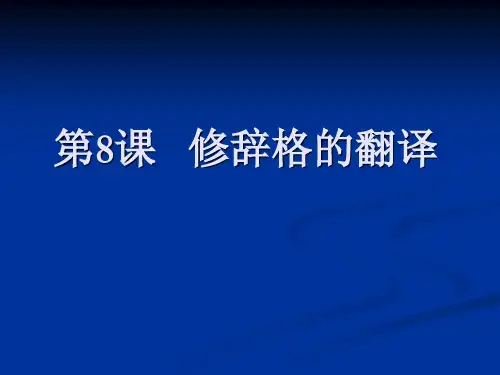


英语常见修辞格分类总结**《英语常见修辞格分类总结工作总结(一)》**在英语学习和使用中,修辞格的运用就像是给语言穿上了华丽的衣服,让表达变得更加生动有趣。
**一、明喻(Simile)让表达更加形象**我觉得明喻这个修辞格就像一个放大镜,能把事物的特点放大,让人们看得更清楚。
就像莎士比亚在他的作品中经常使用明喻,“Shall I compare thee to a summer's day?(我能否将你比作夏日?)”他把心爱的人比作夏天,夏天有着美好的阳光、温暖的气息,这样一比喻,我们就能深刻感受到他对爱人那种热烈的喜爱之情。
我自己在写英语作文或者描述事物的时候,也试着用明喻。
比如说描述一个很害羞的女孩,我会写“S he is like a timid little rabbit.(她就像一只胆小的小兔子)”。
这一下就能让读者在脑海中勾勒出这个女孩害羞的模样。
每次我用明喻的时候,就感觉像是在给读者画一幅画,把我看到的、感受到的,用一种很直观的方式传递给他们。
**二、隐喻(Metaphor)蕴含更深的含义**隐喻啊,它有点像一个神秘的宝藏盒。
表面上看只是普通的一句话,但里面却藏着很深的意义。
拿马丁·路德·金来说,他的演讲中就有很多隐喻。
他说“I have a dream that one da y this nation will rise up and live out the true meaning of its creed: 'We hold these truths to beself - evident, that all men are created equal.'(我有一个梦想,有一天这个国家会站起来,实现其信条的真正含义:我们认为这些真理是不言而喻的,即人人生而平等。
)”这里把美国这个国家的发展隐喻为一个人的“站起来”,暗示着国家走向平等和正义。

英语修辞手法12级商务英语1班高腾学号02011) Simile:(明喻)It is a figure of speech which makes a comparison between two unlike elements having at least one quality or characteristic in common. To make the comparison, words like as, as...as, as if and like are used to transfer the quality we associate with one to the other. For example, As cold waters to a thirsty soul, so is good news from a far country.明喻是将具有共性的不同事物作对比.这种共性存在于人们的心里,而不是事物的自然属性.标志词常用like, as, seem, as if, as though, similar to, such as等.1.In his dream he saw the tiny figure fall as a fly 在他的梦中他看见那小小的人影像苍蝇一般地落了下来。
————《英语文摘》2015-2比喻形象生动,把人影比作苍蝇突出其渺小。
2.The old man’s hair is as white as snow.老人的头发雪白。
———The Washington Post2)Metaphor:(暗喻)It is like a simile, also makes a comparison between two unlike elements, but unlike a simile, this comparison is implied rather than stated. For example, the world is a stage.隐喻是简缩了的明喻,是将某一事物的名称用于另一事物,通过比较形成.1.Life is an isthmus between two eternities. 生活是永恒的生死两端之间的峡道——《21 century》2014-32.I had the muscle, and they made money out of it. 我有力气,他们就用我的力气赚钱.————《英语文摘》2015-2这里用肌肉代指力气,肌肉的功能也就是出力气,直接用肌肉来代表则用了暗喻手法,加强表达效果。
修辞格的翻译方法修辞格在文学创作中起着非常重要的作用,它可以增添语言的美感和表达的深度。
然而,在翻译修辞格时可能会遇到一些困难,因为不同语言之间的文化差异和语法结构的不同会影响到修辞格的表达。
本文将探讨一些常见的修辞格,并提供相应的翻译方法。
1. 比喻比喻是一种常用的修辞格,它通过将一个事物与另一个事物进行类比,来传达一种特定的意义。
在翻译比喻时,译者可以采用直译、意译或借用文化隐喻的方法。
直译可以保留原文的意思,但可能会使翻译变得生硬。
意译可以根据目标语言的习惯表达方式,转换成与原文相似的比喻。
借用文化隐喻则是利用目标语言中的习语或典故,以更好地传达比喻的意义。
2. 拟人拟人是指将非人类事物赋予人类特征和行为的修辞格。
在翻译拟人时,译者可以采用拟人化翻译、反过来拟人化或进行象征性的表达。
拟人化翻译将非人类事物描写成具有人类特征的形象,以增强读者对其感知。
反过来拟人化则是将人类事物描写成具有非人类特征的形象,以达到修辞效果。
象征性的表达则是通过使用象征性的词语或句子,来传达拟人的意义。
3. 反问反问是一种通过提出问题来强调某种观点或表达强烈情感的修辞格。
在翻译反问时,译者可以保留原文的问句形式,或将其转换为断定句来传达其强调的意义。
保留问句形式可以更好地传达原文的情感色彩,但可能会影响到读者的理解。
转换为断定句则可以更直接地表达反问的意义,但可能会丧失一部分原文的情感。
4. 倍数修辞倍数修辞是指通过使用倍数来强调数量或程度的修辞格。
在翻译倍数修辞时,译者可以保留原文的倍数表达,或根据目标语言的习惯表达方式进行转换。
保留倍数表达可以更好地传达原文的程度或数量,但可能会使翻译变得生硬。
转换为目标语言的习惯表达方式则可以更好地适应读者的阅读习惯,但可能会丧失一部分原文的修辞效果。
总结起来,翻译修辞格时,译者应根据具体情况选择适当的翻译方法。
直译可以保留原文的意思,意译可以更好地适应目标语言的表达方式,借用文化隐喻和象征性表达则可以利用目标语言的文化背景和习语,来传达修辞格的意义。
一.相似或关联修辞格(figures of resemblance or relationship)(一)allegory ['ælɪg(ə)rɪ](讽喻;寓言)(二)allusion [ə'luːʒ(ə)n; -'ljuː-](引喻)(三)analogy [ə'nælədʒɪ(类比;比拟)(四)animism ['ænɪmɪz(ə)m](比拟;卡通法;动画法)(五)antonomasia [,æntənə'meɪzɪə; æn,tɒnə-] (借代;换称)(六)conceit [kən'siːt](比附比喻)(七)dysphemism ['disfimizəm](贬损;贬抑)(八)enallage [en'ælədʒɪ](替换)(九)euphemism ['juːfəmɪz(ə)m](委婉)(十)fable ['feɪb(ə)l](寓言)(十一)homericsimile(荷马风格式明喻)(十二)kenning ['kenɪŋ](迂说)(十三)metalepsis [,metə'lepsɪs](借代;转义)(十四)metaphor(隐喻)(十五)metaphor(1)deadmetaphor(融合隐喻终休隐喻)(十六)metaphor(2),alivemetaphor(鲜活隐喻)(十七)metaphor(3),extendedmetaphor(延展隐喻)(十八)metaphor(4),mixedmetaphor(矛盾隐喻)(十九)metaphor(5),metaphorofsuccessionwithoutconfusion(协调隐喻)(二十)metaphor(6),personal(anthropomorphic)metaphor(拟人隐喻)(二十一)metaphor(7),submergedmetaphor(潜性隐喻)(二十二)metaphor(8),organicmetaphor(象征隐喻)(二十三)metaphor(9),telescopedmetaphor(联珠隐喻)(二十四)metaphor(10),sustainedmetaphor(强进隐喻)(二十五)metaphor(11),diminishingmetaphor(玄学派隐喻)(二十六)metonymy(借代;换喻)(二十七)parable(比喻;寓言)(二十八)personification(拟人)(二十九)personification(1)prosopopoeia(拟人)(三十)personification(2)patheticfallacy(拟人)(三十一)personification(3),apostrophe(呼语)(三十二)personification(4)invocation(呼求;乞灵;祈求)(三十三)phanopoeia(示现)(三十四)simile(明喻)(三十五)simile(1),epicsimile(史诗明喻)(三十六)simile(2),homericsimile(荷马风格式明喻)(三十七)synecdoche(借代;提喻)(三十八)trope(比喻)强调或含蓄修辞格(figuresofemphasisorunder-statement)(一)adynation(玄乎夸张)(二)asyndeton(连词省略)(三)adversativeasyndeton(反意连词省略)(四)amplification(渲染夸张)(五)anastrophe(倒装)(六)anticlimax(突降)(七)antiphrasis(倒词)(八)antistoichon(对照)(九)antithesis(对照)(十)aphorism(格言;警句)(十一)apophasis(阳舍阴取;欲取姑舍)(十二)apostrophe(呼语)(十三)invocation(呼求;乞灵)(十四)autoclesis(阳舍阴取;欲取姑舍)(十五)auxesis(夸张)(十六)bathos(突降;弄巧成拙)(十七)climax(阶升)(十八)contrast(比较;反衬)(十九)correction(补充)(二十)pairingsynonym(同义词配搭)(二十一)epanorthosis(补充;补证)(二十二)epigram(隽语)(二十三)jeud’esprit(隽语)(二十四)euphuism(尤菲绮斯体;绮丽体)(二十五)exaggeration(夸张)(二十六)exergasia(尤菲绮斯体;绮丽体)(二十七)hyperbaton(倒装)(二十八)hyperbole(夸张)(二十九)innuendo(暗贬;暗讽)(三十)inversion(倒装)(三十一)irony(悖反)(三十二)irony(1),verbalirony(措辞悖反反语)(三十三)irony(2),situationalirony(情况悖反)(三十四)irony(3),dramaticirony(戏剧性悖反)(三十五)irony(4),tragicirony(悲剧性悖反)(三十六)irony(5),comicirony(喜剧性悖反)(三十七)irony(6),cosmicirony(命运悖反)(三十八)irony(7),theironyoffate(命运悖反)(三十九)irony(8),worldirony(命运悖反)(四十)irony(9),philosophicalirony(命运悖反)(四十一)irony(10),romanticirony(浪漫性悖反)(四十二)irony(11)socraticirony(苏格拉底式悖反)(四十三)irony(12),rhetoricalirony(措词悖反;反语)(四十四)irony(13),dialecticalirony(辩证悖反)(四十五)litotes(含蓄肯定;含蓄悖反)(四十六)meiosis(含蓄陈述)(四十七)negation(含蓄肯定)(四十八)oxymoron(矛盾修饰;精警)(四十九)paradox(矛盾隽语;警策)(五十)paraleipsis(假省略真强调)(五十一)paralepsis(假省略真强调)(五十二)paralipsis(假省略真强调)(五十三)preterition(假省略真强调)(五十四)sarcasm(讽刺)(五十五)satire(讽刺;嘲讽)(五十六)satire(1)horatiansatire(贺拉斯式讽刺)(五十七)satire(2)juvenaliansatire(朱维诺尔式讽刺)(五十八)satire(3)indirectsatire(间接讽刺)(五十九)syncrisis(比较;对照)(六十)syneciosis(对照;反衬)(六十一)systrophe(定义堆累)(六十二)tapinosis(明夸暗损)(六十三)understatement(含蓄陈述)(六十四)vision(示现)三.语音修辞格(figuresofsound)(一)alliteration(头韵)(二)assonance(准押韵)(三)consonance(谐音)(四)dissonance(噪音)(五)repetition(重复)(六)repetition(1),anadiplosis(尾首重复;联珠;顶针)(七)repetition(2)anaphora(首语重复)(八)repetition(3),antanaclasis(原词多义)(九)repetition(4),catchwordrepetition(尾首重复;联珠;顶针)(十)repetition(5),chiasmus(颠倒重复)(十一)repetition(6),correction(矫正重复)(十二)repetition(7),cumulation(同意重复)(十三)repetition(8),echo(回声重复)(十四)repetition(9),epanadiplosis(首词尾复)(十五)repetition(10),epanalepsi(嵌插重复)(十六)repetition(11),epanaphora(首语重复)(十七)repetition(12),epanastrophe(尾首重复)(十八)repetition(13),epanodos(逆转重复)(十九)repetition(14),epanorthosis(矫正重复)(二十)repetition(15),epidiplosis(首词尾复)(二十一)repetition(16),epiphora(尾语重复)(二十二)repetition(17),epistrophe(尾语重复)(二十三)repetition(18),epizeuxis(紧接重复)(二十四)repetition(19),gemination(紧接重复)(二十五)repetition(20)gradation(尾首重复;层递重复)(二十六)repetition(21)identicalrhyme(原词押韵)(二十七)repetition(22),incrementalrepetition(歌谣重复;悬念重复)(二十八)repetition(23),ploce(原词多义;同语新义)(二十九)repetition(24),palilogy(紧接重复;嵌插重复)(三十)repetition(25),paregmenon(同源重复)(三十一)repetition(26),regression(逆转重复)(三十二)repetition(27),symploce(首语、尾语合并重复)(三十三)repetition(28),polyoptoton(转化重复)(三十四)repetition(29),tautology(累赘重复)(三十五)repetition(30),refrain(叠句重复)(三十六)onomatopoeia(摹声)(三十七)melopoeia(音响辅义)四.文字游戏修辞格(verbalgame andgymnas-tics )(一)ambiguity(意中寓意;双关)(二)anagram (拆词命意)(三)antistrophe(同语颠倒重复)(四)doubleentendre(黄色双关)(五)hendiadys(双词单意)(六)hypallage(移就)(七)palindrome(回文)(八)parody(仿拟)(九)paronomasia(双关)(十)portmanteauword(熔合词)(十一)prolepsis(预言示现)(十二)pun(双关)(十三)quibble(双关)(十四)quip(双关)(十五)reverse(易位)(十六)syllepsis(1)(一词多叙)(十七)syllepsis92)(兼顾)(十八)transferredepithet(移就)(十九)zeugma(拈连)五误用收效修辞格(rhetoricalexploitationoferrors)(一)anachronism(超前夸张)(二)bull(言辞矛盾)(三)catachresis(滥用比喻)(四)circumlocution(迂曲)(五)malapropism(误换)(六)metathesis(音位转换)(七)mimesis(模仿)(八)periphrasis(迂曲)(九)spoonerism(字母误换)六.描绘性词语(descriptivewords)(一)bulk(体积描摹)(二)characteristicapposition(特征性同位语)(三)descriptivewords(描写性词语)(四)epexegesis(诠注)(五)epithet(属性词语)(六)homericepithets(荷马式属性词语)英语同源修辞格是一种特殊的重复修辞手法。